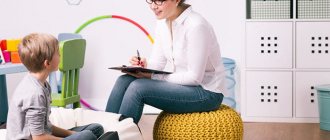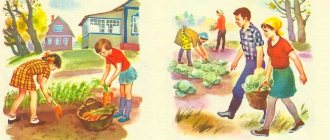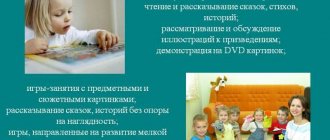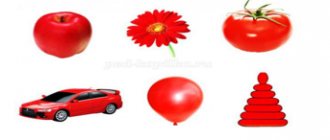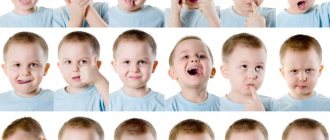Starting from birth, the child constantly develops and grows.
There are certain norms for each age.
Although they are conditional, pediatricians, speech therapists, psychologists, speech pathologists and other specialists monitor the correspondence of the baby’s development to his age.
What level should a child reach at 5 years old?
Features of the 5th year of life
By the age of 5, both boys and girls reach a level where they can be taught the most basic and important things in life. By this age, children begin to understand whether they like the chosen clothes or not, begin to form attitudes towards peers and adults, and accordingly, they develop their own views, opinions and worldviews.
REFERENCE! Both girls and boys at the age of 5 have, to a large extent, visual-figurative thinking.
So, what is the difference between the development of boys and girls at the age of 5?
Boy
At the age of 5, boys are ready to take responsibility for their affairs and actions.
Therefore, this is the best time to entrust him with some of the household chores.
Boys at this age tend to rebel and protest; punishments should be replaced by instructive conversations and explanations.
In addition, this is the best moment to allow your son to choose a sports or creative section.
At the age of 5, it is important for a boy to distinguish between male and female social characteristics, therefore the role of an adult male (father, older brother, grandfather, stepfather) plays an important role. It is he who must explain how a man should behave, what professions are suitable for a man, what qualities he should have.
A mother’s task is to surround her son with love, care and affection.
Girl
Girls are slightly different from 5-year-old boys.
While boys are more aggressive and hot-tempered, girls are characterized by strong impulsiveness, capriciousness and tearfulness.
They should also explain what a woman should be like, what qualities she should have, and this can be done through play or communication.
At this time, girls tend to imitate their idol, so parents need to carefully monitor who their daughter has made her ideal. You need to talk to the child about why she chose this particular character (or person), what is special about him and what qualities he has.
A 5-year-old girl can make one or several girlfriends, try to spend as much time with her as possible, and even be jealous of her other girlfriends. In order for the baby to avoid stress and stop being so jealous of the fact that her friend wants to play with someone else, you need to explain to her what personal space is.
At the age of five, it’s time to send a girl to a circle where she could develop her creative or physical abilities.
Compliments are of particular importance for a 5-year-old girl: parents and relatives should tell her as often as possible that she is beautiful, attractive, smart, that she is the best, and so on. A girl perceives compliments from her father or grandfather better than from her mother or grandmother.
Logic puzzles for children
Logic puzzles for children:
Logic puzzles for children
Logic puzzles for children
Logic puzzles for children
Logic puzzles for children
Logic puzzles for children
Logic puzzles for children
Logic puzzles for children
Logic puzzles for children
Logic puzzles for children
Logic puzzles for children
What should you be able to do?
At 5 years old, a child should independently:
- wash your face and brush your teeth, knowing that this needs to be done morning and evening;
- take off your shoes and outerwear yourself after a walk;
- wash your hands after a walk and before eating and dry them with a towel;
- be able to use cutlery (including a knife);
- take a bath yourself.
In this case, the child can rub himself with a soapy washcloth and wash off the foam, but he cannot be left in the bathroom unattended.
Personal care
Hygiene. For easy access to the sink, we placed a stool and hung a faucet extension. A towel, toilet paper, a basin for dirty clothes - everything is at the child’s level. He uses an adult soap dispenser: he presses with one hand, and places the other palm towards the hole from which soap drips.
During training, I reorganized the storage:
- she laid out combs, elastic bands, beads, bracelets and hairpins in different baskets;
- added teeth cleaning supplies;
- My husband and I hung a lower mirror.
Now if there is silence at home, we understand that the child is in the bathroom.
Dressing yourself. I myself really love order and teach my child to do it. My daughter puts her things back in their place, sometimes we have to remind them or do it together. It is clear that her independence and self-confidence are directly related to the fact that the necessary things are always available.
In the hallway I hung hooks for outerwear and a backpack. Opposite on the shelves in the closet I placed a basket with hats and mittens. Underneath it are stored outdoor toys and a bucket with a sponge and cloth for washing shoes. At the entrance there is a shelf with shoes for the weather, the rest is stored in the nightstand, just like ours.
I organized the wardrobe and hallway areas during the course for children under 3 years old, now I’ve just made small changes to make it even more convenient for my daughter. For example, I added the Trugen stool from Ikea. Dressing on it is clearly better than just on the floor or on an adult sofa, where your feet don’t reach the floor. True, now my daughter also uses it as a ladder to climb onto the sofa.
Children's clothes are stored on hangers and in the chest of drawers. I tried to place things so that they were as visible as possible. The chest of drawers is divided into sections to make it easy to maintain order.
What should you know?
At this age, you can begin to prepare your child for school. Knowledge that should be available to a 5-year-old child:
- Numbers from 1 to 10, as well as the ability to identify them in an image and count the number of objects up to 10;
- Operations of addition and subtraction by 1-2 units;
- Name and image of simple geometric shapes, drawing them;
- Many letters, the ability to write them and indicate the named letter among others;
- Reading by syllables (often, but not always);
- Solving simple logic problems and riddles;
- A collection of simple cubes, construction sets and puzzles;
- Ability to solve problems using the “eliminate the unnecessary” principle and explain the choice.
Puzzles for children 11-12 years old
Puzzles for children 11-12 years old:
Puzzles for children 11-12 years old
Puzzles for children 11-12 years old
Puzzles for children 11-12 years old
Puzzles for children 11-12 years old
Puzzles for children 11-12 years old
Puzzles for children 11-12 years old
Puzzles for children 11-12 years old
Puzzles for children 11-12 years old
Test
The child development test at 5 years old consists of 7 simple tasks. To carry it out, you must first prepare:
- Three separate images of different times of day (morning, evening, night);
- A picture with 10 or more separate objects that the child knows (ball, chair, sun, etc.);
- A picture with 3 circles of different colors;
- A picture with 3 objects known to the child (spoon, pen, telephone).
Tasks:
- Ask what time of year it is.
- Ask “why do birds fly?” or “why do you have to hold on to the handrail on the bus?” You can come up with your own simple question with a cause-and-effect relationship.
- Ask them to name round (square, triangular) shaped objects in the room.
- Lay out pictures of different times of day in front of the child and ask him to name them.
- Ask them to count them in a picture with 10 or more objects.
- In a picture with 3 circles, ask them to name their color.
- Ask to tell what each of the 3 items from the last picture is needed for.
Every correct answer o.
If there is one “—”, it is recommended to conduct the test for children aged 4 years. If there are one or more disadvantages, the child should be shown to a child psychologist.
Puzzles for children - the best selection
Puzzles are an ideal way to show your child that learning can be fun. If you show a little patience and help your child in the initial stages, then over time you will be able to complicate the tasks, thereby developing his logical thinking. You can start with the simplest thing - coloring by numbers. Such a simple task, at first glance, will help develop attentiveness and perseverance.
Puzzles for kids:
Puzzles for kids
Puzzles for kids
Puzzles for kids
Puzzles for kids
Puzzles for kids
Puzzles for kids
Puzzles for kids
Puzzles for kids
Puzzles for kids
Puzzles for kids
Assignments and activities
- Prepare in advance black and white cards depicting two groups of objects (for example, vegetables and fruits, animals and birds, dishes and furniture). Ask them to color one group one color and the other group another color.
- Print ready-made cards for the “find the odd one out” task. Ask the child to name each item, eliminate the unnecessary one and explain his choice.
Read more about educational activities for children 4-5 years old.
Educational puzzles for children
Educational puzzles for children:
Educational puzzles for children
Educational puzzles for children
Educational puzzles for children
Educational puzzles for children
Educational puzzles for children
Educational puzzles for children
Educational puzzles for children
Educational puzzles for children
Educational puzzles for children
Educational puzzles for children
Psychology
Psychologists call the 5-year-old age one of the easiest to educate and develop: the main crises are in the past or await in the future.
At 5 years old, the child already forms his own opinion, but is still able to compromise.
It’s easy to come to an agreement with him if you calmly explain to him why you need to do it this way and not otherwise.
REFERENCE! At the age of 5, children react sharply to criticism.
A 5-year-old child is very inquisitive, asks a lot of questions, wants to know everything and perceives every discovery with great joy.
In communication, children already identify those they like and those they don’t like. They are able to determine their own social circle, refuse friendships with unpleasant peers and adults.
One big disadvantage is the inability to express one’s emotions and thoughts in an adult way. Children tend to be rude and aggressive because they don’t know how to explain that they don’t like a phenomenon, thing or person. The parents' task is to teach him this.
Features of speech
A child of 5 years old is able to clearly formulate his thoughts using words. He knows how to operate with all parts of speech, construct sentences and pronounce them without hesitation.
- The child can clearly pronounce all sounds (an exception may be the sound “r”);
- uses words of all parts of speech in speech, including different declensions, tenses, verb inflections, plural and singular, superlative and comparative degrees of adjectives, etc.;
- knows how to give intonation to a sentence and determine that of the interlocutor;
- can read a poem with expression;
- knows and easily names the last, first and patronymic names of parents, teachers and his own;
- knows his exact address of residence (including region, city);
- knows and does not confuse the meanings of the words “yesterday”, “today”, “tomorrow”, knows the names of food products and dishes, and if he makes a mistake, he corrects himself.
Fine motor skills
By this stage of development, the child’s fine motor skills should be well developed. So, the child should be able to:
- Hold a pencil (pen, brush) correctly and use it with the required pressure;
- Color the picture without going beyond the subject;
- Draw according to the pattern of the figure in the cells;
- Sculpt small parts from plasticine;
- Tie and untie shoelaces.
Picture puzzles for children
Picture puzzles for children:
Picture puzzles for children
Picture puzzles for children
Picture puzzles for children
Picture puzzles for children
Picture puzzles for children
Picture puzzles for children
Picture puzzles for children
Picture puzzles for children
Picture puzzles for children
Picture puzzles for children
Games
For children at this age, play remains the leading activity, so it is necessary to frequently engage them in developmental games.
- Attention game “Clap and Stomp”. The parent invites the child to perform a certain action at the moment of pronouncing a word. For example, clap if he hears the name of a fruit. The presenter (adult) can pronounce any words: house, stairs, sky, apple, cucumber, computer, etc.
- A game to develop fine motor skills and mathematical abilities “Pick the peas.” You need to place a large vessel (cup, vase, pan) on the floor, and give the child a few peas (beans, buttons and other small items are also suitable). There should be exactly as many of them as the child can count, but not less than 10. The child stands next to the vessel, stretches out his hand and, calling out the serial number of the pea, throws it into the vessel. At the end of the game, you need to count how many peas were inside and how many fell past.
A child of 5 years old is already able to competently express his thoughts using words and sentences, express dissatisfaction with a particular event or person, but he is not yet able to express emotions. Only parents can help teach a child to control aggression, anger, hold back tears and overcome moodiness.
Sensory
It makes me happy when I hit a point of interest and the child gets carried away for a long time and tries something. So recently I noticed her craving for construction, and we purchased a magnetic construction set. I spent the whole day building it and couldn’t tear it away.
Developmental activities with sensory materials are very useful from the age of 3 years. They influence fine motor skills and indirectly prepare for writing and mathematics, as well as geometry and creativity. I made several sets with my own hands.
Noise cylinders. I made sound bottles from packages from Imunele - I simply poured beans, buckwheat and semolina into them. It is better to take cereals of different sizes.
Mysterious bag. You need to put objects of different shapes or textures into an opaque bag. The older the child, the less different they should feel to the touch. To complicate the game, you can add a second bag with the same contents. Ask them to find the same objects with different hands.
Paired color cards. A game-exercise on knowledge of colors and all shades. It starts with three basic colors and gradually increases in complexity to seven shades of each color: from the brightest to the palest. I want to get cards from the paint store so I can line up the colors.
We also arrange the chocolate egg fixies according to height. Or while walking in the forest we look for thick and thin trunks.
We have 2 rooms in our apartment: a kitchen-living room and a bedroom. In the living room there is a separate children's bookcase and a shelf for books. I change the materials from time to time, so this is once a creativity zone, once a music and sensory zone, but a set for caring for plants and a jug of water are always in their place. Nearby there is a workplace consisting of a table with a chair and a shelf for books.
